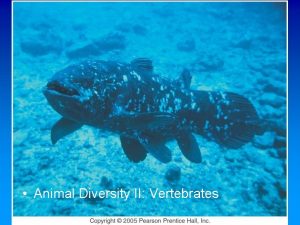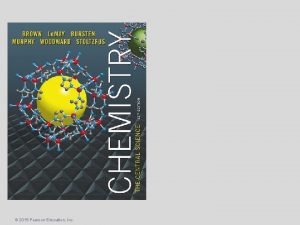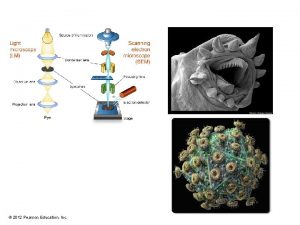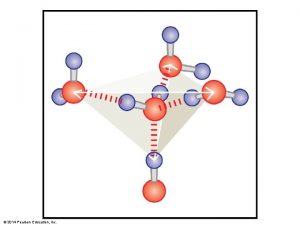Chapter 3 Water Copyright 2005 Pearson Education Inc


























![H 2 O H+ + OH- At equilibrium [H+] = [OH-] = 10 -7 H 2 O H+ + OH- At equilibrium [H+] = [OH-] = 10 -7](https://slidetodoc.com/presentation_image_h2/698755588b1bd5fb983157eea4327152/image-27.jpg)


![LE 3 -8 p. H Scale 0 Increasingly Acidic [H+] > [OH–] 1 Neutral LE 3 -8 p. H Scale 0 Increasingly Acidic [H+] > [OH–] 1 Neutral](https://slidetodoc.com/presentation_image_h2/698755588b1bd5fb983157eea4327152/image-30.jpg)

- Slides: 31

Chapter 3 Water Copyright © 2005 Pearson Education, Inc. publishing as Benjamin Cummings

Overview: The Molecule That Supports All of Life • Water is the biological medium on Earth • All living organisms require water more than any other substance • Most cells are surrounded by water, and cells themselves are about 70 -95% water • The abundance of water is the main reason the Earth is habitable Copyright © 2005 Pearson Education, Inc. publishing as Benjamin Cummings

Concept 3. 1: The polarity of water molecules results in hydrogen bonding • The water molecule is a polar molecule: The opposite ends have opposite charges • Polarity allows water molecules to form hydrogen bonds with each other Copyright © 2005 Pearson Education, Inc. publishing as Benjamin Cummings

LE 3 -2 Hydrogen bonds Copyright © 2005 Pearson Education, Inc. publishing as Benjamin Cummings

Concept 3. 2: Four emergent properties of water contribute to Earth’s fitness for life • Four of water’s properties that facilitate an environment for life: Cohesive behavior Ability to moderate temperature Expansion upon freezing Versatility as a solvent Copyright © 2005 Pearson Education, Inc. publishing as Benjamin Cummings

Cohesion • Collectively, hydrogen bonds hold water molecules together, a phenomenon called cohesion • Cohesion helps the transport of water against gravity in plants • Adhesion of water to plant cell walls also helps to counter gravity Copyright © 2005 Pearson Education, Inc. publishing as Benjamin Cummings

LE 3 -3 Water-conducting cells 100 µm Copyright © 2005 Pearson Education, Inc. publishing as Benjamin Cummings

• Surface tension is a measure of how hard it is to break the surface of a liquid • Surface tension is related to cohesion Copyright © 2005 Pearson Education, Inc. publishing as Benjamin Cummings

Copyright © 2005 Pearson Education, Inc. publishing as Benjamin Cummings

Water has High Specific Heat • The specific heat of a substance is the amount of heat that must be absorbed or lost for 1 gram of that substance to change its temperature by 1ºC • Water’s high specific heat minimizes temperature fluctuations –Heat is absorbed when hydrogen bonds break –Heat is released when hydrogen bonds form Copyright © 2005 Pearson Education, Inc. publishing as Benjamin Cummings

Moderation of Temperature • Water absorbs heat from warmer air and releases stored heat to cooler air • Because of its high specific heat, water can absorb or release a large amount of heat with only a slight change in its own temperature Thus water moderates climate Copyright © 2005 Pearson Education, Inc. publishing as Benjamin Cummings

Evaporative Cooling • Evaporation is transformation of a substance from liquid to gas • Heat of vaporization is the heat a liquid must absorb for 1 gram to be converted to gas • As a liquid evaporates, its remaining surface cools, a process called evaporative cooling • Because of the H-bonds, water has high heat of vaporization, making it a very efficient cooler of organisms and bodies of water Copyright © 2005 Pearson Education, Inc. publishing as Benjamin Cummings

Insulation of Bodies of Water by Floating Ice Most substances contract when cooled, and so does water, down to 4 C; then it expands again. So the bottom of the ocean is never below 4 C Upon freezing, water expands further, and ice is less dense than water • Ice floats in liquid water because hydrogen bonds in ice are more “ordered, ” making ice less dense • If ice sank, all bodies of water would eventually freeze solid, making life impossible on Earth Copyright © 2005 Pearson Education, Inc. publishing as Benjamin Cummings

Copyright © 2005 Pearson Education, Inc. publishing as Benjamin Cummings

The Solvent of Life • A solution is a liquid that is a homogeneous mixture of substances • A solvent is the dissolving agent of a solution • The solute is the substance that is dissolved • Water is a versatile solvent due to its polarity • An aqueous solution is one in which water is the solvent Copyright © 2005 Pearson Education, Inc. publishing as Benjamin Cummings

• Water is an effective solvent because it readily forms hydrogen bonds • When an ionic compound is dissolved in water, each ion is surrounded by a sphere of water molecules, a hydration shell Copyright © 2005 Pearson Education, Inc. publishing as Benjamin Cummings

LE 3 -6 – Na+ + + – – – + – Na+ – + + Cl– – + – Copyright © 2005 Pearson Education, Inc. publishing as Benjamin Cummings + – –

• Water can also dissolve compounds made of nonionic polar molecules • Even large polar molecules such as proteins can dissolve in water if they have ionic and polar regions Copyright © 2005 Pearson Education, Inc. publishing as Benjamin Cummings

LE 3 -7 a Lysozyme molecule in a nonaqueous environment. Copyright © 2005 Pearson Education, Inc. publishing as Benjamin Cummings

LE 3 -7 b Lysozyme molecule in a aqueous environment. Copyright © 2005 Pearson Education, Inc. publishing as Benjamin Cummings

Hydrophilic and Hydrophobic Substances • A hydrophilic substance is one that has an affinity for water • A hydrophobic substance is one that does not have an affinity for water Copyright © 2005 Pearson Education, Inc. publishing as Benjamin Cummings

Solute Concentration in Aqueous Solutions • Most biochemical reactions occur in water • Chemical reactions depend on collisions of molecules and therefore on the concentration of solutes in an aqueous solution Copyright © 2005 Pearson Education, Inc. publishing as Benjamin Cummings

• Molecular mass is the sum of all masses of all atoms in a molecule • Mole: amount of compound where grams = molecular mass • One mole has 6. 02 x 1023 molecules • Molarity is the number of moles of solute per liter of solution Copyright © 2005 Pearson Education, Inc. publishing as Benjamin Cummings

What is the molarity of water? Copyright © 2005 Pearson Education, Inc. publishing as Benjamin Cummings

Concept 3. 3: Dissociation of water molecules leads to acidic and basic conditions that affect living organisms • A hydrogen atom in a hydrogen bond between two water molecules can shift from one to the other: – The hydrogen atom leaves its electron behind and is transferred as a proton, or hydrogen ion (H+) – The molecule with the extra proton is now a hydronium ion (H 3 O+) – The molecule that lost the proton is now a hydroxide ion (OH-) Copyright © 2005 Pearson Education, Inc. publishing as Benjamin Cummings

LE 3 -UN 53 Hydronium ion (H 3 O+) Copyright © 2005 Pearson Education, Inc. publishing as Benjamin Cummings Hydroxide ion (OH–)
![H 2 O H OH At equilibrium H OH 10 7 H 2 O H+ + OH- At equilibrium [H+] = [OH-] = 10 -7](https://slidetodoc.com/presentation_image_h2/698755588b1bd5fb983157eea4327152/image-27.jpg)
H 2 O H+ + OH- At equilibrium [H+] = [OH-] = 10 -7 M (neutral) Most of H 2 O is not dissociated p. H = -log[H+] Neutral p. H = ? ? Acidic p. H: [H+]>[OH-]; basic p. H: [H+]<[OH-]; (>10 -7); p. H ? (<10 -7); p. H ? p. H<7 p. H>7 Life likes p. H 6 -8 Copyright © 2005 Pearson Education, Inc. publishing as Benjamin Cummings

Effects of changes in p. H • Concentrations of H+ and OH- are equal in pure water • Adding certain solutes, called acids and bases, modifies the concentrations of H+ and OH • Biologists use something called the p. H scale to describe how acidic or basic (the opposite of acidic) a solution is Copyright © 2005 Pearson Education, Inc. publishing as Benjamin Cummings

Acids and Bases • An acid is any substance that increases the H+ concentration of a solution • A base is any substance that reduces the H+ concentration of a solution Copyright © 2005 Pearson Education, Inc. publishing as Benjamin Cummings
![LE 3 8 p H Scale 0 Increasingly Acidic H OH 1 Neutral LE 3 -8 p. H Scale 0 Increasingly Acidic [H+] > [OH–] 1 Neutral](https://slidetodoc.com/presentation_image_h2/698755588b1bd5fb983157eea4327152/image-30.jpg)
LE 3 -8 p. H Scale 0 Increasingly Acidic [H+] > [OH–] 1 Neutral [H+] = [OH–] Battery acid 2 Digestive (stomach) juice, lemon juice 3 Vinegar, beer, wine, cola 4 Tomato juice 5 Black coffee Rainwater 6 Urine 7 Pure water Human blood 8 Increasingly Basic [H+] < [OH–] Seawater 9 10 Milk of magnesia 11 Household ammonia 12 13 14 Copyright © 2005 Pearson Education, Inc. publishing as Benjamin Cummings Household bleach Oven cleaner

Buffers • The internal p. H of most living cells must remain close to p. H 7 • Buffers are substances that minimize changes in concentrations of H+ and OH- in a solution • Most buffers consist of an acid-base pair that reversibly combines with H+ Copyright © 2005 Pearson Education, Inc. publishing as Benjamin Cummings
 Copyright 2005 pearson prentice hall inc
Copyright 2005 pearson prentice hall inc Pearson education ltd
Pearson education ltd Copyright pearson education inc
Copyright pearson education inc Copyright 2010 pearson education inc
Copyright 2010 pearson education inc Copyright 2009
Copyright 2009 Copyright pearson education inc
Copyright pearson education inc Copyright 2014 pearson education inc
Copyright 2014 pearson education inc Copyright 2010 pearson education inc
Copyright 2010 pearson education inc Copyright 2010 pearson education inc
Copyright 2010 pearson education inc Copyright by pearson education inc. answers
Copyright by pearson education inc. answers 2008 pearson education inc
2008 pearson education inc Copyright 2009 pearson education inc
Copyright 2009 pearson education inc Copyright pearson education inc
Copyright pearson education inc Copyright 2010 pearson education inc
Copyright 2010 pearson education inc Copyright 2010 pearson education inc
Copyright 2010 pearson education inc Copyright 2010 pearson education inc
Copyright 2010 pearson education inc 2010 pearson education inc
2010 pearson education inc Copyright 2010 pearson education inc
Copyright 2010 pearson education inc Composition copyright example
Composition copyright example Pearson education inc all rights reserved
Pearson education inc all rights reserved Copyright 2009 pearson education inc
Copyright 2009 pearson education inc Copyright 2009 pearson education inc
Copyright 2009 pearson education inc Copyright 2009 pearson education inc
Copyright 2009 pearson education inc Copyright 2009 pearson education inc
Copyright 2009 pearson education inc Copyright pearson education inc
Copyright pearson education inc Pearson education, inc. publishing as prentice hall
Pearson education, inc. publishing as prentice hall Pearson education 2011
Pearson education 2011 Pearson education inc publishing as pearson prentice hall
Pearson education inc publishing as pearson prentice hall Pearson 2012
Pearson 2012 2008 pearson prentice hall inc
2008 pearson prentice hall inc 2005 pearson prentice hall inc
2005 pearson prentice hall inc Pearson education limited 2005
Pearson education limited 2005























































